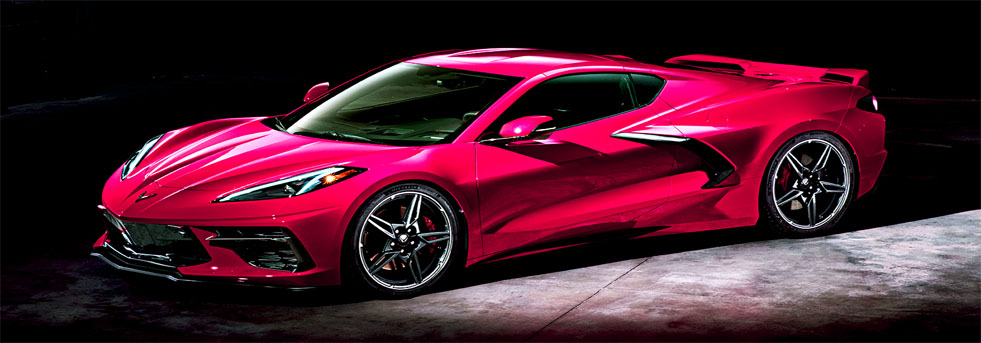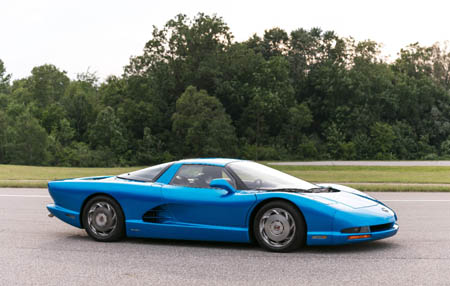|
|
| C8ZoraRegistry.com |
News! January 21, 2023
The C8 CORVETTE 2024 E-Ray IS HERE! CLICK HERE FOR ANNOUNCEMENT, PHOTOS AND VIDEO
2022 CORVETTE Stingray Production and Paint
Trim Combinations:
CLICK HERE
2022 IMSA GTLM Championship C8R Production Numbers:
CLICK HERE

Image: Chevrolet.com

Les Stanford is ready to take your C8 CORVETTE order now!
2020 CORVETTE Stingray Pricing
With its new mid-engine configuration and sleek, modern sesign, the 2020 Chevrolet Corvette Stingray offers unprecedented performance at a starting price of only $59,995. This Corvette pricing guide is complete with all the options to help you calculate Pricing!
CLICK HERE FOR HOT NEWS AND COMPLETE PRICE LIST
A bit of History
The 2020 Chevrolet Corvette Stingray is the culmination of 60 years of
mid-engine experimentation. While the eighth generation Corvette marks a
radical leap forward in terms of capability from the seventh generation,
it also incorporates lessons learned from past engineering exercises
such as the Chevrolet Experimental Research Vehicles (CERVs) I-III, the
Aerovette and others. Below is a little bit of that history......

Zora Arkus-Duntov,
considered the father of Corvette, first encountered early mid-engine
vehicles in his youth, including the Auto Union Types C and D Grand Prix
racing vehicles.
Zora had a wealth of
propulsion knowledge and thrived as an auto racer and
engineering consultant in automotive and aeronautics. He was
attracted to GM by the original Corvette concept, which he saw
at the 1953 Motorama in New York City’s Waldorf Astoria.
|
|
|
The CERV I was outfitted with seven
different engine combinations in its working lifespan, but its
original engine, a Chevrolet Small Block V-8, and its
lightweight aluminum core are both modernized on the 2020
Corvette Stingray.
The primary function of the "CERV-1", was to provide Chevrolet
engineers with a test platform from which direct visual studies were
made from all types of ride and handling behavior under amplified
conditions. In order to realistically amplify vehicle responses to
handling and road stimuli, the performance capability of the vehicle
must be extended far beyond that of regular passenger cars. In other
words, a high power-to-weight ratio is mandatory. By such means,
suspension phenomena that are extremely subtle, and thus difficult to
isolate within the performance capabilities of a regular passenger car,
may be studied and treated quantitatively with the "CERV-1". Another
fundamental factor in the experimental car's design is the visibility
afforded by the body design. The streamlined, abbreviated body encloses
the engine, transaxle, engine cooling system, and provide an open
cockpit for the driver, from which all four wheels, in contact with the
ground, are clearly visible. Some broad features of the "CERV-I" are:
extremely light weight to afford a horsepower-to-weight ratio such as
that usually associated with high performance aircraft; rear mounted
engine in unit with a fully synchronized four-speed transaxle; the only
passenger, the driver, sits well forward on the centerline of the car
for virtually optimum visibility, and all four wheels are independently
suspended to provide a high order of stability and positive handling.
The wheelbase is 96 inches (2,438 mm) and the car weighs approximately
1600 pounds (726 kg), ready to run. The chassis is an extremely stiff
frame of chrome-molybdenum steel tubes welded into a truss-like
structure weighing approximately 125 pounds (57 kg). The lightweight
body (approximately 80 pounds (36 kg)) is aerodynamically styled and
fully encloses the underside of the car. The body is fabricated of a
glass fiber reinforced plastic somewhat thinner than that used in the
Corvette body. The wheels are completely exposed to permit visual
observation of tire-to-road contact during handling studies
|
In 1964, Duntov’s team debuted CERV II, which Duntov and Chevrolet General Manager Semon “Bunkie” Knudsen envisioned as a challenger at Sebring, Le Mans and other races. With torque converters in the front and rear, CERV II employed the first-ever mid-engine four-wheel-drive system, for which Duntov held the patent. Zora Arkus-Duntov began work on the CERV II in 1963, which was completed in 1964. The original plan was to build six cars, three for competition and three spares. The body was styled by Larry Shinoda (who also designed the "63 Stingray) and Tony Lapine. To achieve superior performance, the car was built on a monocoque chassis, powered by a 377 ci all-aluminum single overhead cam V8 with Hilborn injection rated at 500 hp (370 kW). Some test results indicated it had a top speed of 210 mph (338 km/h), and 0-60 mph in 2.8 to 3.0 seconds. Transmission is a 2-speed on each of the front and rear axles, with transferable torque between axles. The top speed was reported to be 200 mph. In 1970, CERV II was used to test tires with a ZL-1 engine. This vehicle and the CERV I were later donated to the Briggs Cunningham Museum, in Costa Mesa, California. |
|
|
The next attempt at a mid-engine vehicle was the 1990 CERV III concept built in conjunction with Lotus to explore future levels of performance. CERV III, more of a road car than a track performer, was intended as a development vehicle to evaluate mid-engine structures. CERV III was powered by a 5.7L, 32-valve dual overhead cam LT-5 Small Block V-8 with twin turbochargers and internal modifications. It produced 650 hp and 655 lb-ft of torque. Top speed of 225 MPH. Corporate Engineering Research Vehicle III was first unveiled at Detroit Automobile Show in January 1986 as the Corvette Indy prototype car. The vehicle featured 4-wheel drive, 4-wheel steering, and CRT cockpit screens. The vehicle was styled by Chief of Chevy III Studio, Jerry Palmer. In January 1990, CERV III (No. 3) made its debut at the International Auto Show in Detroit. The car was made of carbon fiber with a fiberglass-finish coating, with estimated price of $300k-400k. Other standard features include computer-controlled active suspension system, ABS braking and traction control, six-speed automatic transmission, all-wheel-drive and four-wheel steering along with a fully multiplexed electrical architecture. |
|
Zora Arkus-Duntov, retired from GM in 1975, saw the mid-engine layout with the engine located ahead of the rear axle as the optimal configuration for weight distribution, excellent handling and forward visibility. Despite the layout’s innate performance benefits, its implementation in the scheme of mass manufacturing proved problematic.
CERV -V (1992) and CERV IV-B (1997)
On December 1992, General Motors' Corvette group secretly contracted with TDM, Inc. to build a test car of the 1997 Corvette, which was officially called CERV-4 (Corvette Engineering Research Vehicle). The Corvette group directed the project, with the Chevrolet division paying for it. General Motors management was not told about it, for fear of cancellation. It was unveiled by Corvette chief engineer Dave Hill on 1993-5-3 at the General Motors Technical Center in Warren. The build cost was about US$1.2 million.
It was a test mule vehicle for the upcoming Chevrolet Corvette C5. It includes 5.7L LT-1 V8 engine, 6-speed manual transmission axle, 4-wheel disc brakes, front 255/45ZR17 and rear 285/40ZR17 tires on BBS basket wheels, side curtains, no side window glass, and a modified production interior.
The vehicle was sold in 2009 Barrett-Jackson Palm Beach auction for $34000 (before buyer premium).[7] This car is currently on display in Effingham, IL at the MY Garage Museum owned by Michael and Blake Yager.
The previous mid-engine Corvettes were relegated to concept status by issues including engine cooling difficulties, limited passenger and luggage space, loudness and the inability to produce a convertible variant. Advances in development, aided by computer-assisted engineering and virtual reality, helped the current Corvette team carefully plot out the 2020 Chevrolet Corvette Stingray’s architecture. Engineers worked closely with designers to ensure that the vehicle’s form met all of the necessary performance benchmarks, while preserving the Corvette legacy.

Mid-engine was always part of Corvette’s destiny. The 2020 Chevrolet Corvette Stingray pays off the vision of thousands of people who came before it and lives up to Corvette’s core fundamentals of performance, functionality and attainability.
Story and Sources: GM, Chevrolet, Idaho Corvette Page - Images: GM, Idaho Corvette Page



